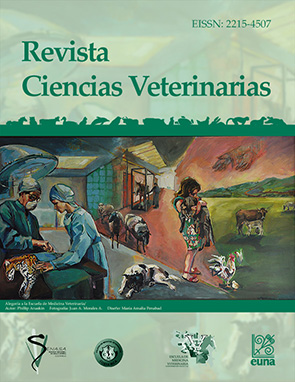Seroprevalence of Leptospira spp. in dairy cattle from the Huetar Norte Region in Costa Rica
DOI:
https://doi.org/10.15359/rcv.34-1.2Keywords:
Leptospirosis, Leptospira, seroprevalence, dairy cattleAbstract
A cross-sectional study was performed in the Huetar Norte region of Costa Rica (2010-2012) to establish seroprevalence to Leptospira spp among dairy cows. This region presents a high incidence of human infection. It also has the largest milk production index in the country. A total of 2375 individual samples was processed using the microscopic agglutination test (MAT), which corresponded to 36 farms belonging to the Dairy Farmers’ Cooperative Cooperativa de Productores de Leche Dos Pinos. Samples yielding a titer ˃ 1:160 were considered positive. Under that criterion a 9.13%, overall seroprevalence was obtained but titers as high as 1:5210 were observed in clinically healthy animals. Seroprevalence among farms was heterogeneous ranging from 0–25%. The most frequently detected serovars were Pomona (15.7%); Tarassovi (16.6%), and Hebdomadis (25.8%). A statistically significant association was detected (p<0.05) between certain serovars and farms. Similarly, water sources used by the farms showed a statistical association (p< 0.05) with seroprevalence to Leptospira spp. (p> 0.05). This association was not identified for the animal’s age or breed (p> 0.05).References
Adler B., de la Peña Moctezuma A. 2010. Leptospira and Leptospirosis. Vet. Microbiol. 140 (3-4): 287-296. doi: 10.1016/j.vetmic.2009.03.012
Andicoberry, A., C.García Peña, F. & Ortega Mora, L. 2001. Epidemiología, diagnóstico y control de la leptospirosis bovina. Investigación Agraria. Producción y Sanidad Animales 16(2): 205–226.
Cachay, E. R. & Vinetz, J. M. 2005. A global research agenda for leptospirosis. Journal of Postgraduade Medicine 51(3): 174–178.
Chirathaworn, C., Inwattana, R., Poovorawan, Y. & Suwancharoen, D. 2014. Interpretation of microscopic agglutination test for leptospirosis diagnosis and seroprevalence. Asian Pacific Journal of Tropical Biomedicine, 4(Suppl 1), S162–S164. http://doi.org/10.12980/APJTB.4.2014C580
Dastis-Bendala, C., Villar-Conde, E., Marin-Leone, I., Manzanares-Torne, L., Perez-Lozano, M. J., Cano-Fuentes, G. & Pumarola-Suñe, T. 1996. Prospective serological study of leptospirosis in Southern Spain. European Journal of Epidemiology, 12(3), 257-262.
Dean AG, Arner TG, Sunki GG, F. R., Lantinga M, Sangam S, Zubieta JC, Sullivan KM, Brendel KA, G. Z. & Fontaine N, Shu M, Fuller G, Smith DC, Nitschke DA, and F. R. 2011. Epi InfoTM, a database and statistics program for public health professionals. CDC.
Faine S. 1999. Leptospira and Leptospirosis. Second Edition. Medisci Press. Melbourne Australia.
González, R., Maranda, L. & Romero, J. J. 2007. Efecto de la vacunación anti-Leptospira en bovinos lecheros sobre la producción de anticuerpos anti-Leptospira en trabajadores de lecherías de cuatro zonas de Costa Rica. Revista Costarricense de Salud Pública 16(30): 39–45.
Levett P.N. 2001.Leptospirosis.Clin. Microbiol.14:296-236.
ILS/WHO. 2003. Human leptospirosis: guidance for diagnosis, surveillance and control. Malta, p. 114.
Maranda, L. 2003. Estudio Experimental Sobre Efectos de la Vacuna Leptofern-5 en Ganado Lechero, en Costa Rica, 2001. Universidad de Davis, California.
Ministerio de Salud de Costa Rica. 2005. Memoria Institucional 2004. San José, Costa Rica.
Ministerio de Salud de Costa Rica. 2009. Memoria Institucional 2008. San José, Costa Rica.
Muñoz, M. 1999. Leptospirosis: Revisión bibliográfica y análisis de la enfermedad en Costa Rica. Universidad Nacional.
Prescott J.F. 1988. Seroprevalence and association with abortion en cattle in Ontario.Can. Vet. J. 52:210-213
Quirós, L. 1995. Leptospirosis: Seroepidemiología en bovinos de Costa Rica y la situación epidemiológica de bovinos y cerdos de la Región Huetar Norte. Universidad Nacional.
Universidad de Costa Rica. 2014. Centro Centroamericano de Población. http://censos.ccp.ucr.ac.cr. (Accessed January 13, 2014)
Van De Weyer LM, Hendrick S, Rosengren L, Waldner CL. 2011. An update on leptospirosis in beef herds from western Canada: Serum antibody titers and vaccination practices. Can Vet J. 52:619–626.
Valverde, M., Ramírez, J., Montes de Oca, L., Goris, M., Ahmed, N. & Hartskeerl, R. 2008. Arenal, a new Leptospira serovar of serogroup Javanica, isolated from a patient in Costa Rica. Infection, Genetics and Evolution 8(5): 529–33. doi:10.1016/j.meegid.2008.02.008
Downloads
Published
How to Cite
Issue
Section
License
Licensing of articles
All articles will be published under a license:

Licencia Creative Commons Atribución-NoComercial-SinDerivadas 3.0 Costa Rica.
Access to this journal is free of charge, only the article and the journal must be cited in full.
Intellectual property rights belong to the author. Once the article has been accepted for publication, the author assigns the reproduction rights to the Journal.
Ciencias Veterinarias Journal authorizes the printing of articles and photocopies for personal use. Also, the use for educational purposes is encouraged. Especially: institutions may create links to specific articles found in the journal's server in order to make up course packages, seminars or as instructional material.
The author may place a copy of the final version on his or her server, although it is recommended that a link be maintained to the journal's server where the original article is located.
Intellectual property violations are the responsibility of the author. The company or institution that provides access to the contents, either because it acts only as a transmitter of information (for example, Internet access providers) or because it offers public server services, is not responsible.







